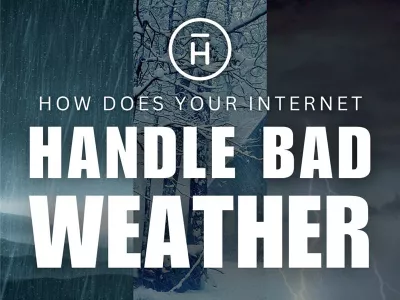Blog
January 22, 2025
How does Satellite, 5G, Cable, and Fiber Handle Bad Weather?

Bad weather can throw a wrench into your plans, causing delays, cancellations, and general inconvenience. But beyond missed events, severe weather can also disrupt your internet connection—a frustrating reality for many. From heavy rain to snowstorms, high winds, or thunderstorms, each weather condition impacts internet technologies differently.
Understanding how the four main types of internet—fiber, cable, 5G, and satellite—respond to weather can help you choose the best service for your needs, especially if you live in areas prone to extreme conditions. Let’s break down the impact of weather on each technology and see why Highline’s fiber network stands out as the best choice.
1. Fiber Internet: The Gold Standard in Weather Resistance
Fiber internet isn’t just fast—it’s the most reliable and weather-resistant option available. By using light to transmit data through ultra-thin glass strands, fiber offers near-light-speed performance, perfect for streaming, gaming, and video conferencing without interruption.
Unlike other internet technologies, fiber cables are largely immune to environmental interference. They’re typically buried underground or protected in conduits, making them resistant to rain, snow, or high winds. However, even fiber isn’t invincible. Extreme weather events like hurricanes, floods, or earthquakes can damage underground infrastructure. Additionally, power outages during storms can interrupt service if backup systems are overwhelmed. But these scenarios are rare, and fiber’s durability ensures it performs reliably in most conditions.
2. Cable Internet: A Relic of the Past
Cable internet, which uses coaxial cables to transmit data, was a game-changer in the 1980s and 1990s. But compared to fiber, it falls short—especially in bad weather. Coaxial cables transmit data as electrical signals, making them more prone to interference than fiber's advanced technology.
Physical damage to cables, such as downed power lines or broken poles caused by high winds or ice, can disrupt service. Water intrusion from heavy rain or melting snow can also degrade signal quality, leading to slower speeds or intermittent outages. If you’ve experienced fuzzy TV reception during storms, you’ll recognize cable internet’s similar struggles.
3. 5G Internet: Speedy but Easily Disrupted
5G internet, a wireless technology using high-frequency radio waves, promises faster speeds than its predecessor, 4G. However, it’s highly susceptible to weather-related interference.
Rain, snow, or even dense fog can weaken 5G signals, causing reduced speeds or service interruptions. The technology’s reliance on high-frequency signals means even physical obstructions like trees or buildings can impact performance. While 5G works well in fair weather, it’s not as dependable as fiber when the skies turn gray.
4. Satellite Internet: Outdated and Vulnerable
Satellite internet connects users via signals sent between Earth and satellites in orbit. While it’s often the only option in remote areas, it’s the most weather-sensitive technology.
Heavy rain, snow, and thick clouds can block or weaken satellite signals, causing slow speeds or complete outages—an issue known as “rain fade.” Hurricanes or snowstorms can damage satellite dishes or knock them out of alignment, requiring time-consuming repairs. For areas with frequent severe weather, satellite internet is a risky choice.
Why Fiber Stands Above the Rest
Fiber internet is the clear winner for weather resilience and reliability. Its cutting-edge technology and thoughtful infrastructure design make it far less vulnerable to environmental challenges than cable, 5G, or satellite. While no system is entirely immune to nature’s extremes, fiber’s ability to withstand the elements is unmatched.
Ready to experience internet that doesn’t falter in bad weather? Check out Highline’s fiber network and see why it’s the ultimate choice for staying connected, rain or shine! Follow Highline’s social pages to learn more.